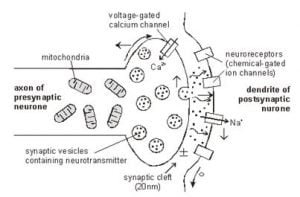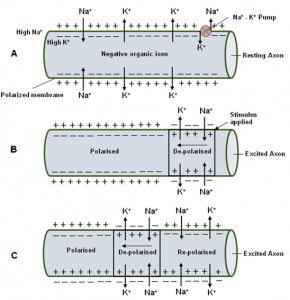A nerve impulse is the electric signals that pass along the dendrites to generate a nerve impulse or an action potential that occur in a neuron due mechanical, chemical or electrical disturbance created by a stimulus.
Transmission of nerve impulse along the nerve fibre is explained by Hodgkin and Huxley in the late 1930 in three steps.
Polarization (Resting Potential)
Depolarization (Action potential)
Re-polarization

Polarization (Resting Potential)
- In the rest state the inside of membrane has –ve electrical potential compared to outside. This difference in potential is called resting potential (about -40mv to -90mv).
- The interstitial fluid has high concentration of Na+ ion which is about 16 times higher outside the neuron than inside neuron. Similarly, the axoplasm has high concentration of K+ ion which is about 25 times higher inside than in outer interstitial fluids.
- Due to difference in Na, K concentration, the Na+ ions diffuse inside the exoplasm and K+ ions tends to diffuse outside of it.
- The membrane of neuron at resting is more permeable to K+ ion than Na+ ion. So, K+ leaves the neuron faster than Na+ enter the neuron.
- Na+and K+ are transported across the membrane against their concentration gradient by carrier protein, which is called Na-K pump and energy is used through ATP.
- The difference in permeability results in accumulation of high concentration of cation (+ve charged ion) outside the neuron compared to the concentration of cation inside.
- The sodium channel and potassium channels on the membrane of neuron are closed.
- This state of resting neuron is called Polarized state and it is electro-negatively charged.
Depolarization or Action Potential
- A stimulus above the threshold which can be initiated by mechanical, chemical and physical stimulation cause the initiation of impulse.
- Sodium channels are opened but potassium channels are closed and Na+ions flood in through cell membrane and create a positive charge of +40mv.
- It is very short periods that change in potential and last for 3 milliseconds.
- When an action potential occurs, the axon is said to be depolarized.
- The depolarization of the membrane stimulates the adjacent voltage channel, so the action potential passes as a wave along the length of neuron.
Repolarization
- Sodium channels are closed potassium channel are opened and K+ions diffuse out along their concentration gradient. This start repolarization and resting potential going to reestablish.
- At the same time nerve become less permeable for Na+than K+ .So many K+ flow out and inside charge become more negative than that it was originally.
- Na-k pump starts and normal concentrations of Na and K ions are reestablished. Each pump actively transports two K+ions into the cell to every three Na+ ions transported out.
- The membrane is once again at its resting potential.
Saltatory conduction:
 Transmission of nerve impulse along medullated nerve fibre is 20 times faster than non medullated fibre. The ionic exchange or depolarization occurs only at nodes because medullary sheath is impermeable to ions. The action potential is conducted from node to node in a jumping manner. This also called saltatory conduction of nerve impulses.
Transmission of nerve impulse along medullated nerve fibre is 20 times faster than non medullated fibre. The ionic exchange or depolarization occurs only at nodes because medullary sheath is impermeable to ions. The action potential is conducted from node to node in a jumping manner. This also called saltatory conduction of nerve impulses.
Mechanism of transmission of nerve impulse across the synapse.
Following are the steps for the process:
1.When an impulse arrives at the pre-synaptic knob of axon Ca++ ions concentrate at the synapse.
2.Ca++ions pass from the synaptic cleft into synaptic knob and cause the movement of synaptic vesicles towards to the surface of knob. Vesicles discharge their neurotransmitters chemicals acetylcholine in to the synaptic cleft and return to the cytoplasm of synaptic knob to refill neurotransmitters.
3.The neurotransmitter binds with protein receptor molecules in synaptic cleft. Na+ ions enter into the cell of another neuron and action potential generates on it. Thus nerve impulse transferred to the next synapse.
4.The acetylcholine is hydrolyzed by an enzyme acetyl cholinesterase into acetic acid and choline in the cleft which are reabsorbed into synaptic knob and resynthesized into acetylcholine using energy from ATP.
